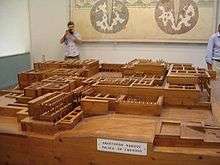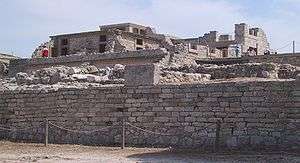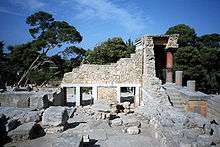Minoan chronology

Sir Arthur Evans developed a relative dating scheme of Minoan chronology based on the excavations initiated and managed by him at the site of the ancient city of Knossos. He called the civilization that he discovered there Minoan. The same scheme was later applied to the Greek mainland and the Cyclades Islands to form a general plan for dating events of the prehistoric and early historic Aegean. The relative chronology is based on the shapes and decorative styles of pottery found at many sites on Crete and elsewhere.
Evans and Knossos
Arthur Evans began excavating on a hill called tou tseleve he kephala, "the headland of the chieftain", some three miles (5 km) from the north coast of Crete, on March 23, 1900. Two of the palace storerooms had been uncovered by Minos Kalokairinos in 1878, whose work ceased at the demand of the land owners. Simultaneously, coins and seals inscribed with a mysterious script were also discovered. These came to Evans' attention as the curator of the Ashmolean Museum at Oxford, a position he held from 1884 to 1908. The area was rumored to have been the site of the ancient city of Knossos.
Evans examined the site on March 19, 1894. Nothing further could be done at that time, but in 1898 Crete became an independent republic. In 1899 Evans purchased the land with his own funds (his family had been factory owners in industrial Britain) and decided to set up an excavation. In the first two weeks he discovered the Linear A tablets, a streak of luck exceeded only by Carl Blegen's legendary first day's dig at Pylos, when he uncovered the Pylos tablets, written in Linear B, a script also found at Kephala and named by Evans.


Attacking the site with crews of hundreds of diggers, Evans uncovered most of the site's 6 acres (24,000 m2) within 6 seasons. By 1905 he had named the civilization whose traces he found there Minoan, after the legendary king Minos, and had created a detailed chronology of the serial phases of the pottery styles in Minoan Crete, based on what he found at Knossos. Subsequently he concerned himself mainly with restoration, an activity frowned upon by archaeologists of today. He continued to excavate there and elsewhere and to restore[1] until 1935.
Evans was knighted in 1911 for his work. In 1921, the first edition of his monumental work, Palace of Minos, was released, which became indispensable for any department of classical archaeology. On Evans' death in 1941, the British School of Archaeology assumed responsibility for the excavation, later turning the property over to the Greek government, while retaining excavation rights.
Evans' chronology
Evans' chronological framework had triple divisions each triply divided, a formula that has been retained, thus Early Minoan (EM) I, II and III, Middle Minoan (MM) I, II and III etc. Each subsection he divided into A and B, early and late. In 1918 Alan J. B. Wace and Carl Blegen adapted Evans' chronology to the Greek mainland and the islands, where the culture was termed Helladic and Cycladic. In 1941 Arne Furumark applied the term Mycenaean to LH and LC. As it is clear that the Mycenaean Greeks dominated at Knossos at some point in Late Minoan (LM), the latter is often included under "Mycenaean" or called "Minoan-Mycenaean".
The major study of Cretan pottery was Evans'. A very general stylistic trend was from dark decoration on a light background in the Early Minoan to white and red decorations on a dark wash or slip in Middle Minoan. Finally, there was a return to the earlier manner of dark on light in Late Minoan.[2] New body shapes for vessels also emerged and various styles of decoration are evident within Evan's chronology.
Evans never intended to give exact calendrical dates to the pottery periods. He did correlate them roughly[3] to better dated Egyptian periods using finds of Egyptian artifacts in association with Cretan ones and obvious similarities of some types of Cretan artifacts with Egyptian ones. Subsequent investigators checking Evans' work varied the dates of some of the periods a little, usually less than a few hundred years, but the chronological structure remains basically as Evans left it, a solid framework for placing events of Aegean prehistory.
Most criticism does not aim at the overthrow of Evans' system, but only complains that it does not capture all the data, such as local variations. Even with these faults the system has no competitors. In 1958 Nikolaos Platon proposed a new chronology at the Prehistoric Conference in Hamburg. In it, the terms "Pre-palace", "Old Palace" and "New Palace" were to replace Evans' scheme. The academic community accepted the scheme but not the replacement, simply stating where in Evans' system the new terms fit.
The one serious question[4] concerns the date of the Knossos tablets. Allegations were made that Evans falsified the stratum in which the tablets were found to place the tablets at 1400 BCE when they ought to have been the same date as the Pylos tablets, 1200 BCE. This dispute became known as the Palmer-Boardman Dispute when it first appeared. Despite the intense debate that developed on the subject no conclusive evidence has yet been found to settle the question. A key part of the case was that a certain kind of vase, a stirrup jar (named from the handles) found in tablet contexts, is dated only to 1200. Other archaeologists hastened to the journalistic scene with instances of similar jars going back to 1400. The search for closure goes on. By default, archaeologists tend to use Evans' dating.
| Other Names | Relative Chronology[5] | Conventional Dates, BCE[6] | Notes |
|---|---|---|---|
| Prepalatial, Pre-Palace (Προανακτορική), Protominoan Age (Platon)[7] Copper Age (Matz, Hutchinson)[8] Early Bronze Age (Hood) |
EM | 3000–2200 (Evans, Hood) 2600–2000 (Matz) |
Πρωτομινωική or ΠΜ in Greek. |
| First Early Minoan (Hutchinson) Phase I (Platon) |
EM I | 3400–2800 (Evans) 2600–2300 (Matz) 2500–2400 (Hutchinson) 3200–2600 (Gimbutas) 3000–2600 (Willetts, Hood) 2800–2200 (Mackenzie) |
The main problem has been setting the end of the Neolithic; its layers were destroyed by building at Knossos.
The period is attested by pottery from a well at Knossos, in Tholos Tomb 2 at Lebena and by an EM I layer at Debla. |
| Second Early Minoan (Hutchinson) Phase II (Platon) |
EM II | 2800–2400 (Evans) 2300-2200 (Matz) 2300–2100 (Hutchinson)[9] 2600–2300 (Gimbutas, Willetts, Hood) |
Seals like those of Egyptian 1st Intermediate Period, Dynasties 6–11, 2345–1991. |
| Third Early Minoan (Hutchinson) Phase III (Platon) |
EM III | 2400–2200 (Evans) 2200–2000 (Matz) 2100–2000 (Hutchinson) 2300–2160 (Gimbutas) 2300–2200 (Willetts, Hood) |
|
| Palace Period (Matz, Platon) Minoan Age (Platon)[10] Full Bronze Age (Matz)[11] |
MM | 2200–1500 (Evans) 2000–1570 (Matz) 2000–1580 (Ventris & Chadwick) |
Μεσομινωική or MM in Greek |
| Phase III of Pre-Palace (Platon) Early Palace (Matz) First or Early Palaces (Hood) |
MM IA | 2000–? (Matz) 2000–1900 (Hutchinson) 2160–1930 (Gimbutas) 2200–2000 (Willetts, Hood) 2000–1925 (Ventris & Chadwick 2200–? (MacKenzie) |
Kephala mound cleared of earlier structures, palace at Knossos begun (Hutchinson). |
| Protopalatial Old Palace (Evans) Early Palace (Matz) Old Palace (Παλαιοανακτορική) Phase I (Platon) First or Early Palaces (Hood) |
MM IB | ?–1800 (Matz) 1900–1850 (Hutchinson) 2000–1900 (Platon, Willetts, Hood) 1925–1850 (Ventris & Chadwick) 1930–1800 (Gimbutas) ?–2100 (MacKenzie) |
"First Palaces" or "First temple-palaces" (Gimbutas)[12] Use of potter's wheel. It may have been introduced in IA. |
| Protopalatial Old Palace (Evans) Early Palace (Matz) Old Palace Phase II (Platon) First or Early Palaces, Middle Bronze Age (Hood) |
MM IIA | 1850–? (Hutchinson, Ventris & Chadwick) 1900–1800 (Platon, Willetts, Hood) 2100–? (MacKenzie) |
|
| Protopalatial Old Palace (Evans) Early Palace (Matz) Old Palace Phase III (Platon) First or Early Palaces, Middle Bronze Age (Hood) |
MM IIB | ?–1700 (Matz, Ventris & Chadwick) ?–1750 (Hutchinson) 1800–1700 (Platon, Willetts, Hood) ?–1900 (MacKenzie) |
Palaces were so destroyed by an earthquake ca. 1700 that they had to be rebuilt. This is the dividing line between Old and New Palace and between II and III.[13] |
| Neopalatial Old Palace (Evans) Late Palace I (Matz) New Palace (Νεοανακτορική) Phase I (Platon) Middle Bronze Age (Hood) |
MM IIIA | 1700–? (Matz) 1700–? (Platon) 1700/1750–1600 (Hutchinson) 1700–1660 (Ventris & Chadwick) 1700–? (Willetts) 1700–? (Hood) 1900–? (MacKenzie) |
Frescoes begin. First pot signs in Linear A. |
| Neopalatial Late Palace I (Matz) New Palace Period Phase I (Platon) Middle Bronze Age (Hood) |
MM IIIB | 1600–1550 (Hutchinson) ?–1570 (Matz) ?–1600 (Platon) 1660–1580 (Ventris & Chadwick) ?–1600 (Willetts) ?–1550 (Hood) 1700–1600 (Palmer) ?–1700 (MacKenzie) |
Linear A. Another earthquake requiring more rebuilding occurred ca. 1570, which for some was the middle of IIIB and for others the start. First Linear A archives from Mallia. |
| LM | 1500–1000 (Evans) | Υστερομινωική or ΥΜ in Greek | |
| Late Palace II (Matz) New Palace Phase II (Platon) |
LM IA | 1550–1500 (Hutchinson) 1600–1500 (Palmer, Furumark) 1570–? (Matz) 1600–? (Platon) 1580–1510 (Ventris & Chadwick) 1700–? (MacKenzie) |
The period of Thera eruption and tsunami.[14] Largest cache of Linear A tablets, Hagia Triada, IA and/or IB. |
| Late Palace II (Matz) New Palace Phase II (Platon) |
LM IB | 1500–1450 (Hutchinson) ?–1450 (Matz) 1510–1450 (Ventris & Chadwick) 1500–1450 (Palmer, Furumark) ?–1450 (Platon) ?–1500 (MacKenzie) |
All the palaces except Knossos were burned ca. 1450, events interpreted by the majority view as the advent of the Greeks and installment at Knossos. |
| Late Palace II (Matz) New Palace Phase III (Platon) Palace Period (Evans, MacKenzie) |
LM II | 1450–1400 (Hutchinson, Palmer, Furumark, Matz, Platon) 1450–1405 (Ventris & Chadwick) |
The period ends with a destruction by fire of all the palaces on Crete from unknown causes.[15] They were, of course, reoccupied. |
| Post-Palace Phase I (Platon) | LM IIIA | 1400– (Matz) 1400–1320 (Platon) 1400–1300 (Hutchinson) |
Linear B tablets ca. 1400 (Evans and his defender, Boardman) |
| Post-Palace Phases II, III (Platon) | LM IIIB | 1300–1200 (Hutchinson) 1320–1280 (II), 1260–1150 (III) (Platon) |
Linear B tablets ca. 1200 (Palmer, doubter of Evans' chronology) |
| LM IIIC | ?–1100 (Matz) 1260–1050 (Willetts) |
A general Mycenaean Greek palace destruction by fire on the mainland and Crete happened in a window of time ca. 1200 at the end of IIIB. How wide a window is not known, nor are the causes for sure. Some possibilities are any or all of civil strife, the Sea Peoples, the Dorians. | |
| Subminoan Age (Platon, Matz, Willetts) | 1100– (Matz) 1150–1000 (Platon) 1075–1025 (Furumark) 1050–900 (Willetts) |
This period is considered a Mycenaean Greek holdout against the Dorian Greeks arriving at this time. Its end marks the completion of assimilation to them. |
Other tables on the Internet
The search for a consistent chronology of Cretan civilization goes on. Other tabular chronologies have been published on the Internet by
- Ian Swindale
- Dartmouth College
- ExploreCrete.com
- World History Encyclopedia
- Thera Foundation
- L. Marangou in the Foundation of the Hellenic World site
- Companion to Manning (Cornell)
- University of Oklahoma.
Notes
- ↑ "Page 4". Webfea-lb.fea.aub.edu.lb. Retrieved 2012-08-10.
- ↑ Sinclair Hood, The Home of the Heroes: The Aegean before the Greeks, 1975, ISBN 0-500-29009-1, Chapter 3, Dating the Bronze Age.
- ↑
- ↑ There are many questions, of course, but this one persists and would overthrow an important part of Evans' chronology. A brief review can be found at the Stanford Archaeopedia site.
- ↑ It is well-nigh impossible to peruse any several books and articles on Crete and come up with anything like a uniform chronology. The underlying reason is no doubt that the time windows of the artifacts are not uniform. Some sites did not experience the full complement of periods; one period got extended over more than one elsewhere. The dates of the periods are not the same everywhere. The utility of a scheme such as Evans' becomes evident in a context such as this. It might be viewed as a median chronological framework.
- ↑ The dates given below are a sampling from the noted works listed in the References section below. Many samples of other noted works might be selected with little likelihood of finding the same dates, but they would tend to vary about Evans' relative chronology. Note also that some of the authors, such as Hutchinson, revised their dates as part of the ongoing process of discovery. Even in different chapters of the same book the reader will find the same period dated differently by the same author.
- ↑ Platon's Pre-Palace Period includes EM and MM IA. His Protominoan Age includes the Neolithic and the Pre-Palace Period.
- ↑ Matz uses "Metal Age" also to comprise Copper and Bronze Ages.
- ↑ The lacuna 0f 100 years is Hutchinson's. As the dates are imprecise, the reader may pick either.
- ↑ Platon's Minoan Age includes MM (exclusive of IA) and LM. His Palace Period includes MM (exclusive of IA) and LM I and II.
- ↑ Matz's Full Bronze Age includes MM and LM I&II (but not III)
- ↑ This hyphenated name is a concession to the view that the palaces were really temples. Those who espouse this minority view use "Temple Period" instead of "Palace Period", etc. A brief discussion of the question is given by Jan Driessen under The Court Compounds of Minoan Crete, Athena Review, Vol. 3 No. 3. All the authors from Evans on recognize that some areas of the palaces found religious uses. On the other hand the throne rooms and private quarters tend to support the "great king" idea. The degree to which the complexes were communal, religious or secular remains open.
- ↑ The events of course are not quite so simple. There was more than one earthquake. Old Palace at Knosses seems to have gone on modified until the middle of IIIA. There is some equivocation also about what building activities constitute "old" and "new", as earthquakes in Crete were frequent and rebuilding ongoing. The transition from old to new should not be regarded as any sharp event. The quest for precision goes on.
- ↑ The date (and effect) of the Thera eruption is as indecisive as the rest of the chronology. Carbon dating indicates the date of the eruption was near 1600 and if that were correct then the time of LMIA would need to change.
- ↑ Furumark divides IIIA into a pre-disaster IIIA1 and a post-disaster IIIA2. The latter is dated by its pottery being found at Amarna, 1375–1350. Most chronologies ignore Furumark's distinction. Until absolute dating showed the Thera eruption to be earlier, Spyridon Marinatos' theory that the eruption caused the disaster prevailed.
References
- Platon, Nicolas, Crete (translated from the Greek), Archaeologia Mundi series, Frederick Muller Limited, London, 1966
- Hutchinson, Prehistoric Crete, many editions hardcover and softcover
- Matz, Friedrich, The Art of Crete and Early Greece, Crown, 1962
- Mackenzie, Donald A., Crete & Pre-Hellenic, Senate, 1995, ISBN 1-85958-090-4
- Palmer, L. A., Mycenaeans and Minoans, multiple editions
- Willetts, The Civilization of Ancient Crete, Barnes & Noble, 1976, ISBN 1-56619-749-X
External links
- Minoan Civilization, Myrtos Museum site.
- The First Great Expansion of Aegean Commerce, Chapter 9 in H. J. Kantor, Plant Ornament in the Ancient Near East
- The Impact of Cycladic Settlers on Early Minoan Crete, article by Philip P. Betancourt in Mediterranean Archaeology and Archaeometry, Vol. 3 No. 1 2003.
- Minoans and Mycenaeans: Sociopolitical & Economic Evidence for LM III Crete at Knossos and Khania
- The Palaces of Minos at Knossos, article by Colin F. Macdonald in Athena Review, Vol.3, no.3: Minoan Crete
- A brief history of Knosós, British School at Athens
- Aegean Archaeology Research Resources UT Arlington
- Settlement Patterns ... in East Crete in the Final Neolithic, Peter Tomkins et al.
- The Rise of the Minoan Palaces, article by Ioannis Georganas in Antistoreton, Issue E985 of 1 July 1998.
- MINOAN TRADE: ASPECTS AND AMBIGUITIES, unrestricted thesis at the University of South Africa, by Deanne Kieser
- Courtyard Complexes and the Labyrinth of Minoan Culture, Michele A. Miller, Athena Review, Vol.3, no.3y